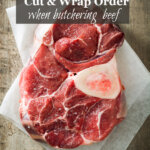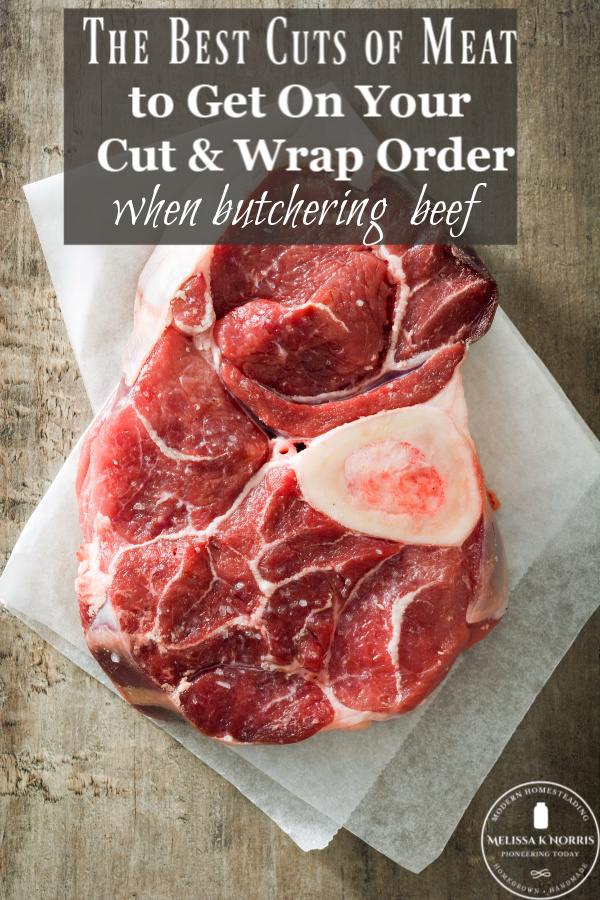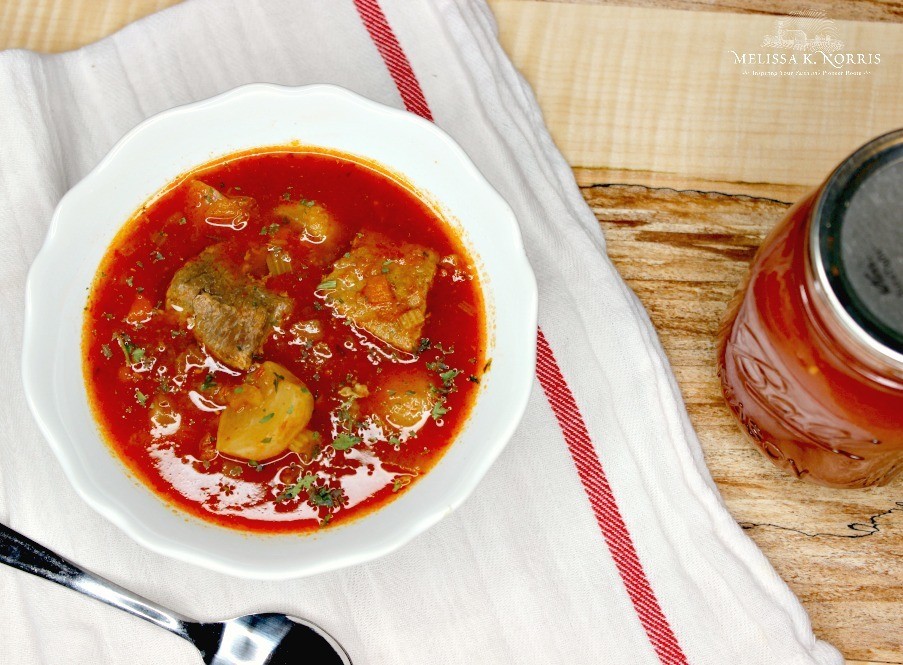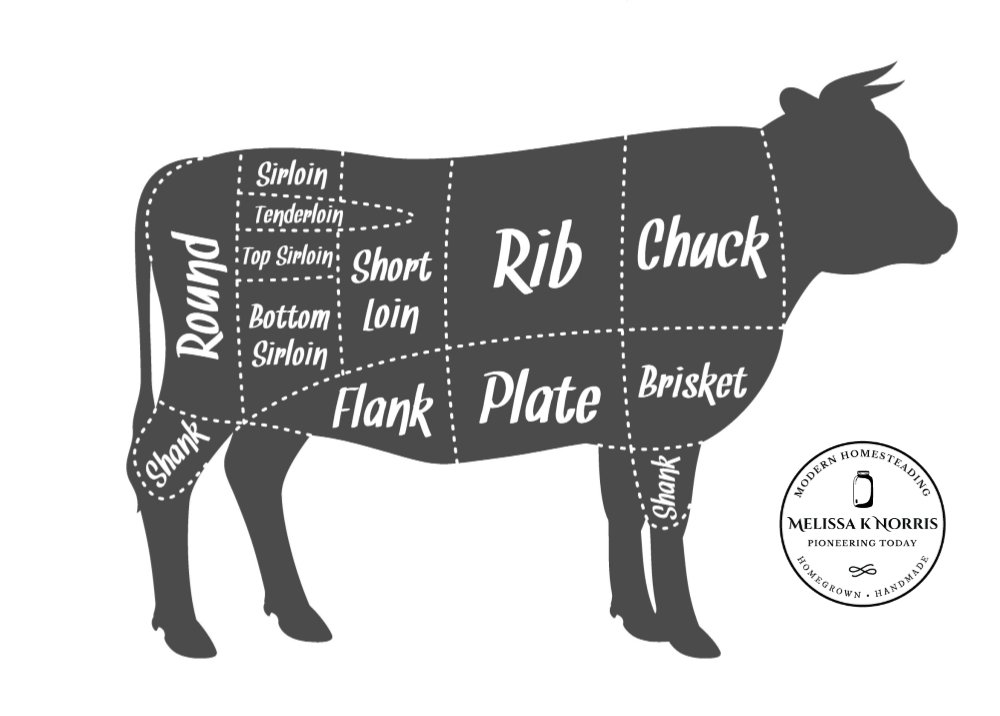How to Order Cuts for Half a Beef?

When getting your beef from a local farmer or raising information technology yourself, you need to know when butchering a cow (technically a bovine and normally a steer or heifer) cuts of meat that are essential to make sure you're getting the nearly from the brute and the cuts that will serve you and your family best.

This is part two of our raising grass fed beef and what you need to know about butchering. If yous missed office one where we talked nearly What You lot Need to Know About Butcher 24-hour interval, you definitely desire to check information technology out. It'south all about what you need to know on butcher day and focuses on the cuts that you tin merely go on butcher day as well equally how to instruct the butcher to handle them. This part of the series will focus on what you need to know for your cut and wrap social club.
Listen in beneath to the total podcast,Episode #216 When Butchering a Moo-cow the Best Cuts of Meat to Get of thePioneering Today Podcast, where we don't just inspire you, just give y'all the clear steps to create the homegrown garden, pantry, kitchen and life you want for your family unit and homestead.
Equally promised we're getting into everything you need to know to tell your butcher to make sure that yous are getting the virtually out of the animal as well every bit the cuts that you and your family unit are going to use. This may vary some and I'll walk you through this, but I want to give yous a good overview of all the dissimilar cuts. And so I volition share with you the cuts that nosotros go and those that are available. Also to be covered are those items that you must request to be given to you lot that is not part of the normal cut and wrap unless specifically requested. The butcher won't enquire you lot if you want them so it's upward to you to ask for them. Many people don't necessarily want them nor will they use them but u.s.a. homesteaders like to get the nearly out of the animals then we practice utilise them.
Update: Technically a moo-cow is a female bovine who has had a dogie, a heifer is a female bovine under two years of age that hasn't had any calves, and a steer is male bovine that has been castrated, a bull is a male bovine that can reproduce. Usually you'll exist getting a steer or heifer as your beef brute.
Y'all'll Need to Choose Package Sizes
One of the things the butcher will ask you is what size package y'all want your hamburger in. Typically, it comes in one, one and a half, or two pounds. That of class depends on your family size and how much meat y'all unremarkably apply when cooking.
With our family of iv we usually just practise a one-pound bundle with our ground meat like hamburger and sausage. If I need two pounds in the event of a potluck, hosting a dinner, or batch cooking and doubling a recipe, then I'k able to simply grab two packages out and know that that'south 2 pounds. For the majority of the time, particularly when doing hamburgers, spaghetti, meatballs, or something like that, 1 pound is very sufficient for us.
The next decision you'll need to brand is how many steaks you'll want per package. For our family of four, usually, I like to accept 2 steaks per package. My daughter is yet young while my son is starting to striking those teenage years and eating more, just fifty-fifty with that nosotros unremarkably are able to split up upward the two steaks betwixt the iv of apply. That gives usa ane meal with no leftovers. Again, this all depends on your family size.
Every bit mentioned in episode 214 Raising Grass-Fed Beef – What Yous Need to Know on Butcher Twenty-four hours, you want the meat to be dry out-aged for at to the lowest degree xiv days, preferably 21 days. Merely earlier that time period is up the butcher will desire your cutting and wrap order so that they tin can get information technology done equally soon as possible, especially when it's a busy flavour. They'll put that order with your beef and so that on the day that they actually cut and wrap everything, they already accept the order information right there ready to go. And then, simply know that within the first couple of days of impale day, they want you to telephone call in with your social club. If you don't call them, they'll telephone call you.
Understanding Beefiness Cut Terminology
When looking at the moo-cow, the USDA divides it into eight regions. These are referred to every bit the primal or master cuts. They are:
- Chuck
- Rib
- Loin
- Round
- Flank
- Short Plate
- Brisket
- Shank
A few of them you may recognize such equally the rib. And yous've probably heard of chuck roast, flank steaks, and brisket, but nosotros're going to get into the nitty-gritty. The butcher looks at the main viii areas. If yous're a visual person I've included a link for a cuts chart in the resources section below.
These primal cuts go further divided into sub-primal cuts. These are cuts that are a cut of meat that is larger than a steak or roast but definitely smaller than half or quarter side of beef. From there they are they're cut into individual size and portion cuts.
The most expensive cuts, which you're not paying more for (as explained in episode 214) when you lot butcher or purchase a whole fauna, you pay the same per pound for all the cuts), merely the about expensive cuts are in the center – the loin and rib section. They are more tender than the outer sections.
If y'all think about information technology, the out department, legs, and cervix which they move have more muscles and muscles mean firmer. Therefore normally they're tougher. If you lot have them aged every bit I recommended, it does assist tenderizes the firmer cuts of meat.
How Does Beef Go Priced When Ownership from a Farmer
Yous pay the farmer per pound of the hanging weight, meaning that after the animal has been gutted. In that location is a split fee that goes to the butcher. There'southward a kill fee. If y'all practise one-half the beef, and so you pay half the kill fee, and then on. And then in that location'southward a per pound cut and wrap. To give yous an idea, our fee to the butcher was $0.65 per pound.
Now that we've covered what the central cuts and sub-primal cuts are, nosotros'll get into the actual cuts of meat that are available to you lot. You have a lot of unlike cuts that you lot can get from the middle, merely usually, there are more than cuts per area of meat than y'all'll be able to get. This might be a bit confusing only a butcher will walk you lot through if y'all have questions when you lot're doing your cut and wrap order.
A Cut By Whatsoever Other Name
To make things a little more confusing, sometimes the same cut can have different names. The short loin is a great instance of this. The T-bone and porterhouse steak are both from the curt loin and actually are the aforementioned steak. Only here's the departure: The porterhouse is a bigger version of the T-bone. Most people are familiar with a T-bone steak considering it has that bone that looks like a T which divides the meat. I one side you lot accept the filet while the other side has a strip steak.
A strip steak has a lot of different names too such every bit NY strip, KC strip, and hotel steak. So you lot can have different variations of the proper name, only they hateful the same thing.
The tender cuts from the eye are unremarkably a:
- T-bone steak
- Strip steak
- Porterhouse steak
- Rib eye
- Rib steak
- Filet mignon
We no longer become the T-bone steak because we all want the super tender side and none of us want the tougher side. Instead, we get the rib steak which is our favorite because the flavor and texture are just amazing. We as well become the New York steak for our family size. Tin can't beat the flavor and texture either.
Just in case you were curious, if yous're ownership a half or a quarter of a beef, it's not similar yous just get the front quarter and just get cuts from that section, such as the chuck. They accept all the eight dissimilar areas and and so divide them up evenly between 2 or 4.
Which beef butchering cuts exercise you lot need to know?
There are 8 primal cuts on beefiness and so your subprimal cuts for individual cuts of steak, roasts, etc.
one. Chuck
Chuck is the meat that comes from the shoulder and can sometimes be considered tough merely super flavorful. Types of cuts you lot'll see from the chuck region:
- Ground chuck (hamburger)
- Flat-iron steak
- Chuck short ribs
- Shoulder tender medallions
- Chuck pot roast
- Bract roast
- Boneless chuck curt ribs
- Stew meat – Try our favorite Quondam-fashioned Beef Stew Recipe – Instant Pot or Slow Cooker
- Country style ribs
- Top blade steak
- Chuck heart roast
- Arm mail service roast
- Shoulder pot roast
- Mock tender roast
- Nether bract roast
- 7-bone pot roast
- Flanken-style ribs
- Cross rib roast
Simply considering all those cuts come from the same expanse does not mean that you're going to go every unmarried one of them. In fact, most times you can't go every single 1 considering some cuts take specific areas of the meat to get one type of cutting, while another blazon of cut could likewise include that surface area. It just depends on what you want as to how the butcher is going to cut upward the area.

I'll requite you an case. We love pot roast because they are the most tender and have the most flavor, melt with the about consistently melt in your mouth flavor and texture. Nosotros don't actually like flat iron steaks, top blade steaks, or any steaks from the chuck region considering they're going to be tougher. They're non as tender so we don't desire them. I definitely practice like to get stew meat to put in stews, or brand barbecued beef (it works very well).
So I'll go stew meat and pot roasts from the chuck surface area and anything that is left I accept them grind into hamburger.
ii. Brisket
Next up is the brisket, which is the chest of the animal, exist it a steer or a moo-cow. Virtually of the time it'll be a steer because it gives more meat per fauna because steers grow larger and faster than a moo-cow. A two-twelvemonth-erstwhile steer is going to outweigh a ii-year-old moo-cow by a lot. They're more than advantageous for the farmers because they're more cost-effective. Nosotros breed our ain and two years in a row our calves have been heifers (unbred cow). It's non worth it to try to take that heifer to market place and to sale and sell and then try to buy a steer. So we do butcher our cows and take never noticed a difference in flavour.
The brisket expanse has a lot of fat in it but can exist kind of tough. This part commonly gets tenderized: barbecue brisket, corned beef, pastrami are all examples of the main uses for this cutting of meat. We don't usually get the brisket and have it ground up into hamburger instead. Nosotros use a lot of burger because information technology's and so versatile.
3. Shank
The third area is the shank. This is the animate being'due south forearm, which falls in front of the brisket. Usually, this is considered the toughest cut of meat.
This is the area that soup bones come up from, which yous definitely desire to become. The meat is actually really practiced on a soup os and yous'll be surprised at the amount of meat that is on the os. Information technology'southward non just a os.
I make broth with it which cooks the meat. Once that'south done, I remove the os from the goop, let information technology absurd a bit so that I can take the meat off the bone. Then I'll accept the meat and put it back in the broth and make soup with it.

Any extra meat that I don't become equally soup bones, I take ground up into hamburger.
4. Ribs
Ribs are next up. I think we're all pretty familiar with the rib department on an animal, cow's ribs and backbone. There are xiii pairs of ribs, but it'south the final section – half-dozen through 12 – that is in the primal section of the ribs. The others are in what we consider the chuck department.
Inside the ribs, there is a lot of marbling which gives it great flavour. They're ane of my favorite things. Barbecued ribs…oh you lot guys, that'southward one of my favorites! Demand a charcoal-broil sauce recipe? Try this Homemade Barbecue Sauce or my Sweet and Smoky Barbecue Sauce.
The types of cuts available from the ribs department:
- Delmonico steak
- Boneless ribeye roast
- Cowboy steak
- Ribeye steaks
- Beef short ribs
- Rib roast
- Back ribs
That marbling not but gives phenomenal flavor, but we know that it also helps requite us dandy tender cuts.
Now, the back rib cutting is the big affair of ribs that you're used to seeing. I don't become the ribeye roasts because I desire the ribeye steaks, which can have the bone or exist boneless.
5. Plate
The plate department is the other source of short ribs and is constitute near the abdomen. Information technology'southward a little scrap fattier. The meat is usually used for:
- Fajitas
- Pastrami
- Skirt steak (cut into carne asada cut)
- Philadelphia steak
- Curt ribs
Have I mentioned I really like ribs? And then I definitely request ribs. We also order the carne asada cut (aka skirt steak) because nosotros dear a good Carne Asada.
6. Loin
The loin area contains what are typically the most expensive cuts if purchasing in a shop. It's located at the summit, directly behind the ribs. Since these muscles hither aren't heavily used, the meat is very tender.
The loin section is cleaved downwards into two subsections: the curt loin and the sirloin. Popular cuts from the curt loin are:
- Filet mignon
- Tenderloin steak
- T-bone steak
- Porterhouse steak
- Strip steak
- New York strip steak
- KC Steak
- Top loin steak
The sirloin area is thought to be a little less tender than the short loin, but it has more flavour. Some common cuts are:
- Sirloin steak
- Eye cutting sirloin steak
- Acme sirloin
- Lesser sirloin
- Ball tip steak
- Tri-tip steak
7. Circular
Area number 7 is the round. This is your lean and cheap cuts typically past then hind end and at the hind legs so can sometimes be tough but not usually super tough. Again, with the leg and shoulder areas, you'll see basis beef from them. Some of the cuts that you get from this area:
- Round steak
- Center of round
- Tip steak
- Tip roast
- Height circular
- Bottom round roast
- Boneless rump roast
I've tried cooking rump roast in a dull cooker but I tin can never get that son of a gun to always get super tender and good so I don't even bother. We have all made into hamburger. That'south just personal preference though. If you know how to cook a melt in your mouth, delicious, boneless rump roast, please do share it with me considering maybe I'thou missing out on something.
eight. Flank
The final area is the flank. Information technology'south located below the loin and has no bones. Information technology'due south lean, flavorful, simply tough. It used to exist pretty inexpensive but people now want more than lean meat. Probably not us homesteaders though since nosotros all like our lard and tallow. The 2 main cuts from the flank surface area are:
- Flank steak
- London bake
Similar I said, with those tougher areas that we aren't having made into steak cuts or roasts they tin can plow them into basis beef and ground beef patties, stew meat, kabob meat (more evenly cut and a little flake smaller than stew meat), and strips such equally fajita or carne asada cuts.
Those are your 8 areas and how they're cleaved downward into dissimilar cuts.
How to Find a Local Source
If you tin't find a local farmer you can contact your local butcher. Oftentimes they will sell meat independently also, but they should also be able to point you in the direction of some local farmers.
Non-Standard Cuts
Marrow/Femur Bones
Now we're going to talk about the cuts that aren't normal that haven't been covered all the same that you might not be familiar with. First upward, are the marrow and/or femur bones. This is the large leg of the cow and not what your soup basic come up from. Often people presume that's what the soup bones are but as we talked about earlier, the soup basic have meat on them.
But when you ask for the marrow or femur os there will be no meat fastened to them. They will be just bones. You can asking that the butcher cutting them up into three-inch pieces.
The reason you lot want this is that it makes beautiful broth because the bones take been cut open so you have all that marrow from that large leg bone. Because of all that marrow,yous'll get a gel similar no tomorrow. It's gorgeous and yous'll beloved it.
Some other way that you tin use them is by roasting them. My son and husband love the marrow from roasted bones. It'south like a effeminateness. A lot of other nations and cultures love bone marrow and will use them this way too.
Be sure to ask the butcher to chop them upward for you though. You desire to make sure you lot can admission and get the most marrow out of the bones as possible.
Tallow
The other thing that yous may or may want to get, totally up to you, is the tallow. Tallow is the fat from a cow. When it's grunter fatty, it'southward called lard. With beef, it's called tallow. Some people think that tallow is a lot smellier and information technology's a lot harder.
Unlike lard, tallow is not something that yous'll desire to utilise to make your pie crusts and things like that.
Now, you lot tin can definitely use tallow for frying and cooking, only what near people similar to use tallow for is for salves, balms, and soap making.

You'll need to return it downwards just like you lot would lard. Back in the pioneer days, they also used the fatty as their candles. At present, a lot of people feel tallow is smellier than lard and so they don't like to use it for candles because of the smell. Information technology'south very nourishing to the peel so it's slap-up to employ in your soaps, balms, salves, and ointments.
If you're interested in making soak and learning how to make your own homemade herbal balms and salves, and even candles and then you are going to want to check out my Homemade Soap, Bath & Trunk System. It walks you through making your own homemade soap, making your own candles, and making your different whipped body butters, salves, balms, and ointments.
There are a couple of different ways you tin ask for the tallow to be given to you. Some people ask for the fatty to be ground up because the smaller the pieces the easier information technology is to melt evenly when rendering it down to get the impurities out. I actually prefer mine to be in chunks and so I'll chop it upward into cube form. When it's footing-up at that place's more meat in the fatty. When I ask for it in strips I don't go as much meat on it. I don't desire the meat on it because that's what I'm trying to exit. I want pure fatty.
If you lot don't ask for them, you won't go the femur basic nor the tallow. So definitely as for them if you want them.
Resources:
Cuts Chart
Pioneering Today Academy
Order theFamily unit Garden Program: Raise a Yr'southward Worth of Sustainable and Healthy Nutrient and all the bonuses to grow your own food here . You lot'll learn cold frames and flavor extenders, composting, and and so much more!
I hope you enjoyed learning when butchering a moo-cow cuts of meat you lot demand to know to become the most from your beef!
Other Posts You May Bask
- Planning Our Livestock to Raise a Year'due south Worth of Food
- Stocking Up on Brute Feed (+ How Much to Feed Animals)
- Raising Your Own Grass-Fed Beef
- Pros and Cons of Raising Your Own Beef
- Raising Grass-Fed Beef – What to Know on Butchering Mean solar day
- Dairy Cow 101: Everything You Need to Know
- How to Butcher a Craven
- Tips on Raising Chickens for Meat
- Raising Meat Chickens for Profit
- Raising American Guinea Hogs
- American Republic of guinea Hogs – Were They Worth Information technology?
- Tips on Raising Pigs for Meat
- A Guide to Raising Goats
- Raising Sheep for Fiber & Naturally Dyeing Wool
- Everything You Need to Know About Raising Rabbits for Meat
- How to Keep Animals Cool in Hot Conditions
Source: https://melissaknorris.com/podcast/when-butchering-a-cow-cuts-of-meat-to-get/